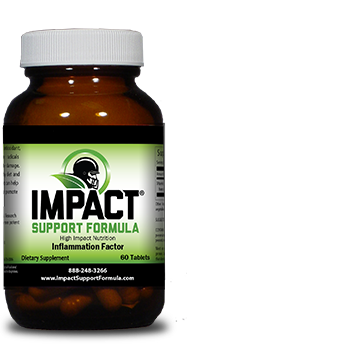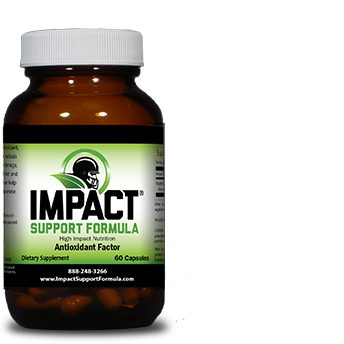
The Science
The recommendations of rest and aspirin are not enough.
Use extra-strength inflammation support nutrients
that have shown results in case studies.
References
- Arterburn, L.M., Hall, E.B. & Oken, H. (2006). Distribution, interconversion, and dose response of n-3fatty acids in humans. American Journal of Clinical Nutrition, 83(6), 1467-1476.
- Bradbury, J. (2011). Docosahexaenoic acid (DHA): an acient nutrient for the modern human brain. Nutrients, 3, 529-554.
- Cunnane, S.C. et al. (2012). Plasma and brain fatty acid profiles in mild cognitive impairment and Alzheimer’s Journal of Alzheimer’s Disease, 29(3), 691-697.
- Das, M., Mohapatra, S. & Mohapatra, S.S. (2012). New perspectives on central and peripheral immune responses to acute traumatic brain injury. J Neuroinflammation, 9(236),
- Engstrom, K., Saldeen, A.S., Yang, B., Mehta, J.L. & Saldeen, T. (2009). Effect of fish oils containing different amounts of EPA, DHA, and antioxidants on plasma and brain fatty acids and brain nitric oxide synthase activity in rats. Upsala Journal of Medicine Sciences, 11(4), 206-213.
- Gallagher, C.N. et al. (2009). The human brain utilizes lactate via the tricarboxylic acid cycle: a 13c-labelled microdialysis and high-resolution nuclear magnetic resonance study. Brain: A Journal of Neurology, 132(10), 2839-49.
- Gu, Y., Schupf, N., Cosentino, S.A., Luchsinger, J.A. &Scarmeas, N. (2012). Nutrient intake and plasma ß-amyloid. Neurology, 78(23), 1832-40.
- Hall, E.D., Vaishnav, R.A. & Mustafa, A.G. (2010). Antioxidant therapies for traumatic brain injury. Neurotherapeutics: The journal of the American Society for Experimental Neurotherapeutics, 7(1), 51-61.
- Hall, E.D., Vaishnav, R.A., & Mustafa, A.G. (2010). Antioxidant therapies for traumatic brain injury. Neurotherapeutics: The Journal of the American Society for Experimental NeuroTherapeutics, 7, 51-61.
- Hashimoto, M. & Hossain, S. (2011). Neuroprotective and ameliorative actions of polyunsaturated fatty acids against neuronal diseases: beneficial effect of docosahexaenoic acid on cognitive decline in Alzheimer’s disease. Journal of Pharmacological Sciences, 116(2), 150-62.
- Hein, A.M. & O’Banion, M.K. (2009). Neuroinflammation and memory: the role of prostaglandins. Molecular Neurobiology, 40(1), 15-32.
- Horio, Y., Hayashi, T., Kuno, A. & Kunimoto, R. (2011). Cellular and molecular effects of sirtuins in health and disease. Clinical Science, 121(5), 191-203.
- Laird, M.D., Sangeetha, S.R., Swift, A.E.B, Meiler, S.E., Vender, J.R., & Dhandapani, K.M. (2010). Curcumin attenuates cerebral edema following traumatic brain injury in mice: a possible role for aquaporin-4? Journal of Neurochemistry, 113(3), 637-648.
- Loef, M. & Walach, H. (2013). The omega-6/omega-3 ratio and dementia or cognitive decline: a systematic review on human studies and biological evidence. Journal of Nutrition in Gerontology and Geriatrics, 32(1), 1-23.
- Meehan, W.P. (2011). Medical therapies for concussion. Clinical Sports Medicine, 30(1),
- Mills, J.D., Bailes, J.E., Sedney, C.L., Hutchins, H. & Sears, B. (2011). Omega-3 fatty acid supplementation and reduction of traumatic axonal injury in a rodent head injury model. Journal of Neurosurgery, 114(1), 77-84.
- Nilsson, A., Radeborg, K., Salo, I. & Bjork, I. (2012). Effects of supplementation with n-3 polyunsaturated fatty acids on cognitive performance and cardiometabolic risk markers in healthy 51 to 72 years old subjects: a randomized controlled cross-over study. Nutrition Journal, 11,
- Patterson, Z. R. & Holahan, M. R. (2012). Understanding the neuroinflammatory response following concussion to develop treatment strategies. Front Cell Neurosci, 6(58),
- Petraglia, A.L., Winkler, E.A., & Bailes, J.E. (2011). Stuck at the bench: potential natural neuroprotective compounds for concussion. Surgical Neurology International, 2,
- Prokop, S., Miller, K.R. & Heppner, F.L. (2013). Microglia actions in Alzheimer’s disease. Acta Neuropathol, 126(4), 461-77.
- Ramlackhansingh, A.F. et al. (2011). Inflammation after trauma: microglial activation and traumatic brain injury. Annals of Neurology, 70(3), 374-83.
- Russell, K.L., Berman, N.E. & Levant, B. (2013). Low brain DHA content worsens sensorimotor outcomes after TBI and decreases TBI-induced timp1 expression in juvenile rats. Prostaglandins Leukot Essent Fatty Acids, 89(2-3), 97-105.
- Sharma, S., Zhuang, Y., Ying, Z., Wu, A., & Gomez-Pinilla, F. (2009). Dietary curcumin supplementation counteracts reduction in levels of molecules involved in energy homeostasis after brain trauma. Neuroscience, 161(4), 1037-44.
- Simopoulos, A.P. (2008). The omega-6/omega-3 fatty acid ratio, genetic variation, and cardiovascular disease. Journal of Clinical Nutrition, 17, 131-134.
- Taber, K.H., & Hurley, R.A. (2013). Update on mild traumatic brain injury: neuropathology and structural imaging. Journal of neuropsychiatry and Clinical Neurosciences, 25(1), 1-5.
- Toklu, H.Z., Hakan, T., Biber, N., Solakoglu, S., Ogunc, A.V., & Sener, G. (2009). The protective effect of alpha lipoic acid against traumatic brain injury in rats. Free Radical Research, 43(7), 658-67.
- Van De Rest, O., Van Hooijdonk, L.W.A., Doets, E., Scheipers, O.J.G., Eilander A. & De Groot, L.C.P.G.M. (2012). B vitamins and n-3 fatty acids for brain development and function: review of human studies. Annals of Nutrition and Metabolism, 60(4), 272-292.
- Wu, A., Ying, Z. & Gomez-Pinilla, F. (2010). Vitamin E protects against oxidative damage and learning disability after mild traumatic brain injury in rats. Neurorehabil Neural Repair, 24(3), 290-8.
- Wu, A., Ying, Z. & Gomez-Pinilla, F. (2013). Exercise facilitates the action of dietary DHA on functional recovery after brain trauma. Neuroscience, 17(248), 655-63.
- Wu, A., Ying, Z., Schubert, D. Gomez-Pinilla, F. (2011). Brain and spinal cord interaction: a dietary curcumin derivative counteracts locomotor and cognitive deficits after brain trauma. Neurorehabil Neural Repair, 25(4), 332-342.
- Zetterburg, H., Smith, D.H. & Blennow, K. (2013). Biomakers of mild traumatic brain injury in cerebrospinal fluid and blood. Nature Reviews Neurology, ,. 201-210.
- Zhang, F., Wang, S., Gan, L., Vosler, P.S., Gao, Y., & Chen, J. (2011). Protective effects and mechanisms of sirtuins in the nervous system. Prog Neurobiol, 95(3), 373-395.
Choose Brain Function Formulations
That Doctors and Pharmacists Choose
Inflammation Factor
“Inflammation Factor.” That says it all when it comes to supporting the health of your brain and nerve tissue, and not just your joints.
Inflammation Factor has a blend of turmeric (a plant of the ginger family), rosemary (a herb) and calcium to help give your brain and nerve tissue support.
- Promotes a healthy inflammation response
- Contains turmeric standardized to 95°/o as curcumin-the most studied component of turmeric.
- Provides 35 mg of rosemary extract - standardized to contain at least 40°/o ursolic acid.
- Curcumin and rosemary provide all-natural inflammation and antioxidant support.
- Serving size is 1 tablet • Contains calcium phosphate for improved absorption.
- Guaranteed potency and purity. GMP (Good Manufacturing Process) Certified.
Omega Factor
There are many health benefits of fish oil. Your brain's ... Omega Factor is a highly concentrated fish oil softgel containing more than twice as much eicosapentaenoic acid (EPA) and docosahexaenoic acid (DHA) as standard fish oil products.
- EPAX® fish oil, the most clinically documented fish oil in the world
- 1400 mg highly concentrated fish oil softgel
- Each softgel contains a minimum of 448 mg EPA, 308 mg DHA, and 154 mg other omega-3s
- Natural lemon oil flavor
- Molecularly distilled and tested for pesticides, PCBs and heavy metals
- Includes natural IPP non-GMO mixed tocopherols for additional antioxidant protection of the fats
- EPAX® fish oil is certified by Friend of the Sea (FOS) for compliance with sustainable operations, from fish harvesting to finished omega-3 concentrates
Antioxidant Factor
If you've done your homework, you know the health benefits of antioxidants, along with inflammation support.
Think of the joints. Now think of the vital brain!
- Alpha-lipoic acid is used in Antioxidant Factor because of its ability to easily pass into the brain and nerve tissue
- 300mg extra-strength antioxidant alpha-lipoic
- Serving size is only 1 capsule
- Guaranteed potency and purity. GMP (Good Manufacturing Process) Certified
Questions or Concerns?
Do you have questions about any of our products? Call 800-598-0394 or send a message to [email protected]


